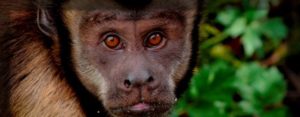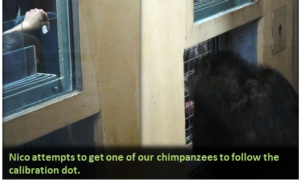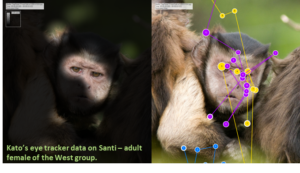
On October 31st, Living Links researchers Dr. Nico Cladiere and Dr. Juan Carlos-Gomez welcomed Jon Ward from Acquity ETS Ltd to trial a Tobii infra-red eye tracking device with our primates. The tracker was trialled with our East group of capuchins, squirrel monkeys and the Budongo Trail chimpanzees.
This type of non-invasive technology has been designed for humans and is well used in a many fields, such as cognitive and developmental psychology, linguistics research, neuropsychology and can also be helpful in diagnostics of mental disorders.
Infra-red eye trackers have been tested with great apes and macaques, but as far as we are aware this is the first time this type of technology has ever been trialled on capuchin and squirrel monkeys.

Our attempts with the squirrel monkeys were promising, but they did not stay still long enough for the tracker to detect their eyes.
 The chimpanzees did show some interest in the trials and the machine was able to pick up their eye gaze when they were shown pictures of chimpanzee faces however no data were recorded from the chimps as we were unable to calibrate the machine. In order for the tracker to work properly it must be calibrated by the study subject following the calibration dot.
The chimpanzees did show some interest in the trials and the machine was able to pick up their eye gaze when they were shown pictures of chimpanzee faces however no data were recorded from the chimps as we were unable to calibrate the machine. In order for the tracker to work properly it must be calibrated by the study subject following the calibration dot.
The greatest success of proof of concept was with the capuchin Kato (a 7 year old periphery male from the East group). He came into the cubicles, sat in position and easily followed the calibration dot. After he successfully did this he was shown a variety of pictures of other capuchins in his group and some from the West. The photos were of females and males of varying ranks.
Watch the video to see where Kato looked for each of the monkeys. The size of the red dot is indicative of the length of time Kato spent on that point on the screen, the red lines show the pattern of his gaze as it moves.
The eye tracking system is able to display the data in a variety of ways. We can see the length of time spent focusing on one area and track where the gaze goes over time.

This visualisation was created by two trials. The yellow is the first set of tracks and the purple the second. They are numbered so you can see the gaze pattern.
The software is also able to show length of gaze through light and shadow. The longer the monkey stares at one area of a picture the lighter it becomes.


Both Juan and Nico were very impressed by this technology and its potential for countless benefits to the studies here in Living Links. Just from the quick trials we were able to see Kato’s tendency to avoid staring at the eyes of the alpha males and the fact he looked directly at the eyes of the females from the neighbouring group. This type of data can enlighten us on the group dynamics, hierarchies and the ability of our monkeys to recognise individuals. The tool may also be useful in social learning studies as well as the evolutionary development of various cognitive processes.











